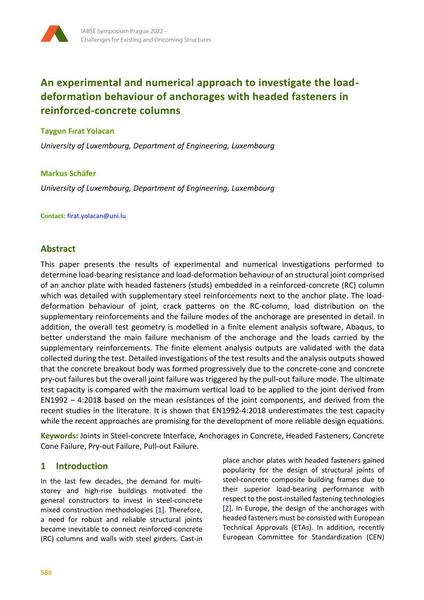An experimental and numerical approach to investigate the load- deformation behaviour of anchorages with headed fasteners in reinforced-concrete columns

|
|
|||||||||||
Bibliographic Details
| Author(s): |
Taygun Fırat Yolacan
(University of Luxembourg, Department of Engineering, Luxembourg)
Markus Schäfer (University of Luxembourg, Department of Engineering, Luxembourg) |
||||
|---|---|---|---|---|---|
| Medium: | conference paper | ||||
| Language(s): | English | ||||
| Conference: | IABSE Symposium: Challenges for Existing and Oncoming Structures, Prague, Czech Republic, 25-27 May 2022 | ||||
| Published in: | IABSE Symposium Prague 2022 | ||||
|
|||||
| Page(s): | 586-593 | ||||
| Total no. of pages: | 8 | ||||
| DOI: | 10.2749/prague.2022.0586 | ||||
| Abstract: |
This paper presents the results of experimental and numerical investigations performed to determine load-bearing resistance and load-deformation behaviour of an structural joint comprised of an anchor plate with headed fasteners (studs) embedded in a reinforced-concrete (RC) column which was detailed with supplementary steel reinforcements next to the anchor plate. The load- deformation behaviour of joint, crack patterns on the RC-column, load distribution on the supplementary reinforcements and the failure modes of the anchorage are presented in detail. In addition, the overall test geometry is modelled in a finite element analysis software, Abaqus, to better understand the main failure mechanism of the anchorage and the loads carried by the supplementary reinforcements. The finite element analysis outputs are validated with the data collected during the test. Detailed investigations of the test results and the analysis outputs showed that the concrete breakout body was formed progressively due to the concrete-cone and concrete pry-out failures but the overall joint failure was triggered by the pull-out failure mode. The ultimate test capacity is compared with the maximum vertical load to be applied to the joint derived from EN1992 – 4:2018 based on the mean resistances of the joint components, and derived from the recent studies in the literature. It is shown that EN1992-4:2018 underestimates the test capacity while the recent approaches are promising for the development of more reliable design equations. |
||||
| Keywords: |
concrete cone failure Joints in Steel-concrete Interface Anchorages in Concrete Headed Fasteners Pry-out Failure Pull-out Failure
|
||||
| Copyright: | © 2022 International Association for Bridge and Structural Engineering (IABSE) | ||||
| License: | This creative work is copyrighted material and may not be used without explicit approval by the author and/or copyright owner. |
||||
